Lecture5Word
unit5words分析
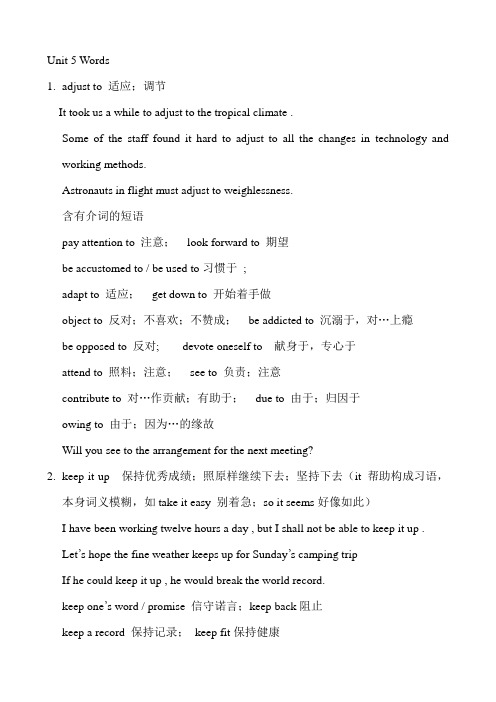
Unit 5 Words1.adjust to 适应;调节It took us a while to adjust to the tropical climate .Some of the staff found it hard to adjust to all the changes in technology and working methods.Astronauts in flight must adjust to weighlessness.含有介词的短语pay attention to 注意;look forward to 期望be accustomed to / be used to习惯于;adapt to 适应;get down to 开始着手做object to 反对;不喜欢;不赞成;be addicted to 沉溺于,对…上瘾be opposed to 反对; devote oneself to 献身于,专心于attend to 照料;注意;see to 负责;注意contribute to 对…作贡献;有助于;due to 由于;归因于owing to 由于;因为…的缘故Will you see to the arrangement for the next meeting?2.keep it up 保持优秀成绩;照原样继续下去;坚持下去(it 帮助构成习语,本身词义模糊,如take it easy 别着急;so it seems好像如此)I have been working twelve hours a day , but I shall not be able to keep it up .Let’s hope the fine weather keeps up for Sunday’s camping tripIf he could keep it up , he would break the world record.keep one’s word / promise 信守诺言;keep back阻止keep a record 保持记录;keep fit保持健康keep in touch with 与…保持联系keep up(with)赶上;不落在后面;keep out of不使…入内keep in mind 把…记在心里;keep one’s balance 保持平衡keep away from 不接近;keep hold of 抓住keep an eye on sth. 注意看守某物,照看某物3.fit in with sb /sth 与…相适应/相融和She doesn’t fit in with the rest of the class.He’s never done this type of work before ; I’m not sure whether he’ll fit in .I’d like to fit my arrangement in with yours .We tried our best to make our garden fit in with its surroundings.It’s necessary for us to fit in with the times.4.We should queue (up) for a bus here.They are queuing up to see a film .People had to stand in a queue for hours to but a ticket .Please Qup!5.Our school has a big cafeteria.6.Mr Smith gave a lecture on how to learn English well.Not all can lecture on modern art.Do stop lecturing me .a lecture tour attend a lecture give sb a lecture give a lecture7. qualification n. 资格;资历qualify v. 取得资格;修饰;限制qualified adj. 合格的;及格的;有资格的be qualified for / to do 有资格做某事quality n. 品质;素质without qualification无条件的have the right qualifications for sth / to do sth 有资格做某事be well qualified for sth / to do sthHe has got a medical qualification .(考试及格证书,执照)He has the right qualifications for the job .(资格常用pl)What qualifications have you got to apply for this job?7.preparation n. 准备;预备make preparations for 做准备in preparation 在准备中in preparation for (为某事物)做好准备prepare sth. 准备某事prepare for sth. 为…做准备prepare to do sth. 准备做某事be prepared for sth. /to do sth. 对某事做好准备prepare sb. for sth.使某人对某事做某事He did too little preparation for his examination.Plans for selling the new products are now in preparation.She is making preparations for her marriage .The teachers are busy preparing the test while the students are busy preparing forthe test.9.recommend (vt.)推荐,赞许(常与介词to,as, for连用)recommend sth to be =recommend sb.sth. 向某人推荐或介绍某物recommend sb. as 推荐某人为recommend sb./sth. for 推荐某人做(职位);推荐某人做某种用途Can you recommend a good dictionary to me ?Can you recommend me a good novel ?They recommend him for the job./ as a good lawyer .劝告,建议recommend doing sth / sb to do sth / that …(should) do sth / sb sthI recommend buying this dictionary .The doctor recommends his patient to go out for a walk .The teacher recommended that everyone should take an active part in the English party.10. comfort n. 【U】安慰;舒服;舒适【C】令人感到安慰的人或事Vt. 安慰comfortable adj. 舒服的;舒适的;uncomfortable adj.In comfort 舒服地It’s a comfort to 对…来说是安慰They did everything for our comfort .The news brought comfort to all of us .He is a great comfort to his parents.The child ran to his mother to be comforted.John was terribly upset, and we all tried to comfort him.She comforted herself with the thought that it would be soon spring.11. substitute n. 代替者;代替品vt. 用…代替…substitute A for B = substitute B with/by A 用A代替Bmake a substitute 替换substitution n. 替换Honey is often used as a substitute for sugar.He is a substitute player on the team .We must substitute a new chair for the broken one.In China many people substitute coffee with tea .a substitute for sb/sth …的代替品as a substitute 作为代理人近义词组:take the place; take one’s place; replace; instead of; instead;in the place of12. He is an academic in Oxford University.(大学讲师,高等学校的学生)The academic year usually starts in September .He possessed no academic qualifications.(学术的证书)(n) academy学院,专科院校13. requirement n. 修要;要求require vt. 修要;要求;命令require sth of sb. 要求某人做某事require doing sth. 修要做某事require that (should ) +v.Our latest model should meet your requirements exactly.(依赖或需要的事物常用pl)Not all foreign visitors satisfy the legal entry requirement .(规定或要求的事物)Do you know the requirement that every applicant (should) have a medical examination?If you have any requirements , ask me.Look at your shirt! It requires washing.14. revise vt. 复查;修正;复习revision n. U 复查;修正;复习do some revision for the exam为考试做准备15. There is an essay on the causes of the World War I .The book contains a number of interesting essays on women in society.(n) essayist16. There is a tutor to teach the children while they’re in hospital .Her tutor says she is making good progress.17. draft n. 草拟,草案【C】Vt. 草拟;起草be drafted in the army 被征召入伍This is the only draft of my speech, but what do you think of it?I’m still drafting the first chapter.I’ve made a rough draft of the letter .This is only the first draft of the letter .I’ll draft a letter for you .18. The shock left me numb .She was numb with terror .Her fingers were numbed by the cold .numbly (adv) numbness (n)19. acknowledge vt. 承认;确认;答谢;打招呼acknowledgement n. 承认. 感激acknowledge sb./sth. 感激,承认或认可某人某物acknowledge doing sth/thatacknowledge sb./sth. to be / as 承认某人某物是acknowdledge sb. 向某人打招呼,问候it is universally acknowledged that…是大家公认的Do you acknowledge your fault?He acknowledged it to be true .They had to acknowledge the need for reform.He acknowledged having been defeated at last.His services to the country were never officially acknowledged .It is/ was acknowledged that …. a generally acknowledged fact She was generally acknowledged as the finest poet in the word.I was standing right next to her, but she didn’t even acknowledge me.20.as/so far as one is concerned 就…而言As far as I know就我所知. As far as I am concerned , I can’t object to your marriage .As far as English is concerned , he is the best in our class .As far as I am concerned, what other people thought was not the most important thing.As far as English is concerned, I think it should be taught in primary school.in terms of …. 就..而言considering (prep.)…就..而言,考虑到.. 21. contradict vt. 反驳;驳斥The two statements contradict each other.It’s contradiction to love animals and yet wear furs.The witness contradicted the driver’s statement .(反驳,驳斥,否认)I’m afraid what you said yesterday contradicts what you are doing .(相抵触,相矛盾)The two stories contradict each other .contradiction n. 反驳;矛盾;对立contradictory (adj)互相矛盾的,对立的be contradictory to sth = contradict sthcontrary adj. 相反的,相对的on the contrary 恰恰相反22.occupy vt. 占用;占领;占据occupied (adj)没空闲的,忙碌的occupation (n)占用,职业under occupation 在占领中lose one’s occupation 失业fixed/ regular occupation固定职业by occupation 职业上be fully occupied 忙得不可开交The speeches occupied 3 hours .Many problems occupied his mind .军事占领The army occupied the enemy’s capital .占有房屋,土地等They occupy the room next door .担任某职务My sister occupies an important position in her firm .忙着做某事occupy sb/ oneself in doing sth / with sthbe occupied in doing sth / with sthShe occupied herself with routine office tasks .I have been occupied in reading books .23.enterprise n. 事业;计划;公司;企业/事业单位;商号;商行【C】事业心;进取心【U】enterprising adj. 有事业心的;有进取心的The music festival is a new enterprise which we hope will become an annual event.A woman of great enterprise事业心极强的女子24. apology n. apologize v.make an apology to sb.apologize to sb. for sth.demand an apology accept one’s apologyMarge should apologize to her daughter for reading her diary.He made an apology for his remarks.We should offer our apologies for the delay to your flight today.He made an apology to me for losing my book .25.We are trying to get the baby into a routine for feeding and sleeping .The fault was discovered during a routine check .26. optional subjects at school 选修科目compulsory (adj)义务的,强制的27. day in and day out 日复一日= day after dayday by day 一天天的,逐渐的. Day in and day out , no matter what the weather is like , she walks ten miles .28. He left out a bark of laughter .The dog suddenly started barking at us .29. drill n./v. 钻机;钻孔;钻n./v. 操练;训练钻孔Drill a series of holes in the frame .They are drilling for oil off the Irish coast .培训The children were drilled how to leave the classroom quickly when the fire bell rang.操作,作..的演习The soldiers were being drilled outside the barracks .钻头机床He made a hole with a drill .练习,训练We had drills in English grammar .演习There’ll be a fire drill sometime this morning .They are drilling a new tunnel under the Thame.New recruits have three hours of drill a day.The well-drilled crew managed to rescue most of the passengers.The children were drilled how to leave the classroom quickly when the fire bell rang.30. Our agent in New York deals with all US sales .agency (n)代理机构,经销机构31. parallel adj. 平行的;相同的;类似的;be parallel to /with 与…平行;类似have no parallel 没有相似点;without parallel 无可比拟The road and the canal are parallel to each other .与..平行,和..相似My opinion is parallel to yours.The war was a unique event, without parallel in history.32. abundant adj. 丰富的;大量的;abundance n. 丰富;大量;充足. be abundant in …= be rich in 丰富;盛产In abundance 大量;丰盛;充裕Our country is abundant in natural resources.We have abundant evidence to prove his guilt .The timely snow suggests an abundant year.33. govern v. 统治;支配;管理govern a country / your temper/ a machinegovernment n. 政府;统治;控制;管理governor n.省长;州长;总督The country is governed by elected representatives of the people .34. We will arrive at our destination by the evening .35. out of the question 不可能的;不值得讨论的out of question 毫无疑问的= without questionAnother trip abroad this year is out of the question .Without ______ passport , leaving the country is out of ______ question.A. the;/B.a; /C. a; /D. the ; the36. settle in /into (迁入新居或更换工作)安顿下来settle down 定居;从事固定职业;安静下来We only moved house last week and haven’t settled in yet. Settle down kids, and eat your dinner.I haven’t yet settled in my new job .I’m sure she’ll settle in to her new home soon .。
lecture 5 汉英词语翻译
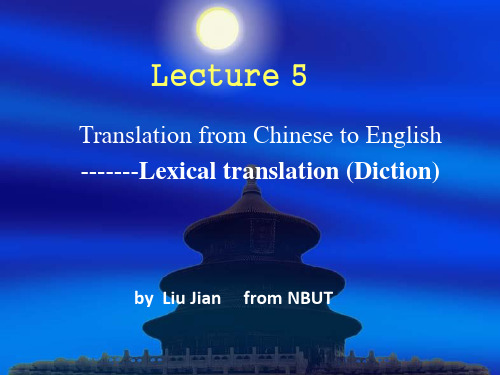
7). 昨天看电影我没有买到好票:
* I did not buy a good ticket for yesterday’s film. I did not buy a good seat for yesterday’s film.
8). 这所全国重点大学为社会输送了大批人才
(batches of )。 * The national heavy university has sent/transported batches of qualified talents to the society. The national key university has prepared batches of qualified graduates for the society. 9). 他们省吃俭用,为的是攒钱买房子。 * They save food and expenses to accumulate more funds to buy an apartment. They live frugally/economically/thriftily to accumulate more funds to buy an apartment.
Appropriateness in word selection-ii
To choose word according to the collocation 2). 好: 好教徒 好父母 好儿女 好妻子 好丈夫 3). 水平: 英语水平 生活水平 游泳水平
2) good a faithful/devout/pious/sincere/ devoted Christian/believer a loving/caring parent an obedient/filial child a virtuous/devoted wife a dutiful/responsible husband 3) level English proficiency/ level living standard swimming skill
Lecture--5--Word-Formation-《英语词汇学》第五章教案

Lecture 5讲授题目:Word Formation Ⅰ❖所属章节:《现代英语词汇学概论》之第3章❖计划学时:4 periods❖教学方法:传统讲授法❖参考资料:《英语词汇学教程》、《英语词汇学》❖教学目的和要求:通过本单元的学习,学生对英语的构词法有初步了解,尤其是产出新词最多的三种主要构词法:词缀法、复合法、转类法。
❖教学重点:1) Affixation;2) Compounding;3) Conversion.❖教学难点:The above-mentioned word-formations.The expansion of vocabulary in modern English depends chiefly on word-formation. There is a variety of means being at work now. The most productive are affixation, compounding and conversion.According to Pyles and Algeo (1982), words produced through affixation constitute 30% to 40% of the total number of new words; compounding yields 28% to 30% of all the new words; conversion gives us 26% of the new vocabulary. The rest of new words come form shortening including clipping andacronymy, amounting to 8% to 10%, together with 1% to 5% of words born out of blending and other means.Talking about word-forming patterns means dealing with rules. But a rule of word-formation usually differs from a syntactic rule. Not all the words that are produced by applying the rule are acceptable. For example, the existence of the actual English words unclean, unwise, unfair does not ensure the acceptance of unsad, unexcellent.Therefore, rules themselves are not fixed but undergo changes to a certain extent. For example, the Old English –th which is found in warmth, length, depth, width, derived from adjectives warm, long, deep, wide,but broad is no longer used to form new word broadth (※coolth)---(Quirk, et al 1985).By word-formation processes, we concentrate on productive or marginally productive rules. While applying the rules, we should remember that there are always exceptions.(在构词过程中,我们要注意到活跃性和边缘性问题。
简明英语测试教程Lecture 05
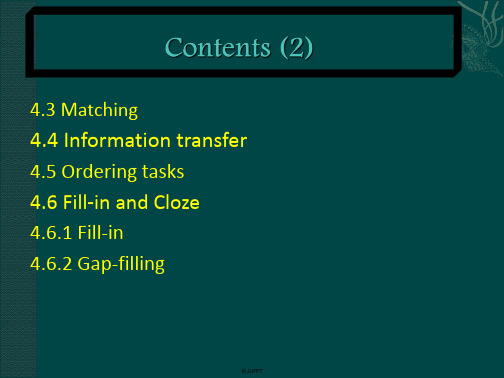
N) technology O) victims
精品PPT
4.3 Matching
4.4 Information transfer
4.5 Ordering tasks
4.6 Fill-in and Cloze
4.6.1 Fill-in 4.6.2 Gap-filling
(1. to 2 affect/influence 3. Others 4. each/them
From Integrated course Book 2, Unit 1)
精品PPT
Today, I went to the ________ and bought some milk and eggs. I knew it was going to rain, but I forgot to take my ________, and ended up getting wet on the way ________.
……
A) acting B) assuming C) comprehensive D) cooperative E) entire F)
especially G) forward H) images I) information J) offers K) projects
L) respectively M) role
2 ___
C. because it was one he and Richard had learnt at school 3 ___
D. Peter looked outside
4 ___
E. He recognized the tune
5 ___
F. and it seemed deserted
lecture用法最全详解(含习题)

2.lecturelecture /ˈlektʃə(r)/ 词频4n. 讲座;讲课;教训. vi. (开)讲座;讲课. vt. 训斥派:lecturer 词频2 n.演讲者;(大学)讲师①高义频vi.&n.(尤指大学中的)讲座;讲课;演讲go to/attend a lecture 听讲座deliver/give a lecture做讲座a lecture on/about 关于……的讲课/训斥e.g. He lectures on literature at Manchester University. 他在曼彻斯特大学教文学。
②低义频vi.&n.教训;训斥lecture sb. about/on...因……训斥某人give sb. a lecture 给某人一个教训e.g. He’s always lecturing me about the way I dress. 他总是对我的穿着说三道四。
e.g. I know I should stop drinking-don’t give me a lecture about it.我知道我该戒酒,别教训我了。
1.单词拼写(1)I went to the ___(讲座) he gave in the hall.(lecture)(2)He learned a ___(教训)from this thing-he should stop smoking for his health.(lecture)(3)Professor Smith will give a l___ in Fudan University this evening about the history of English.(lecture)(4)She suffered a bad cold. As a result, she missed the ___(讲座) she liked very much.(lecture)(5)She preferred that we should have the discussion right after the ___(讲座).(lecture)(6)Please stop___(lecture) me! I know I should quit smoking.2.语法填空(1)The ___ (lecture) spoke very clearly so that we could hear every word.(lecturer) 3. 完成句子(1)He ___ ___ ___ ___time management to first-year students___ ___ ___ ___.他在报告厅给一年级学生做关于时间管理的讲座。
Lecture 5:Important distinctions
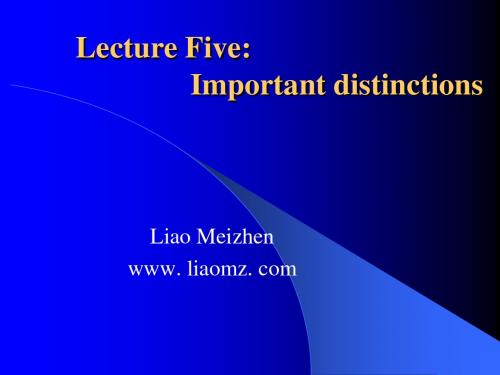
According to Chomsky, a speaker has internalized a set of rules, about his or her language, which enables him to produce and understand an infinitely large number of sentences and recognizes sentences that are ungrammatical and ambiguous. A speaker still makes mistakes, caused by social and psychological factors.
Diachronic linguistics, on the contrary, will study relations that bind together successive terms not perceived by the collective mind but substituted for each other without forming a system.
*It exists only by virtue of a sort of contract signed by the members of a community. Moreover, the individual must always serve an apprenticeship in order to learn the functioning of language; a child assimilates it only gradually.
1. 2 Parole: speaking
Parole refers to the realization of language in use. Parole is the concrete use of the conventions and application of the rules. Parole varies from person to person, and from situation to situation.
语言学笔记 Lecture5
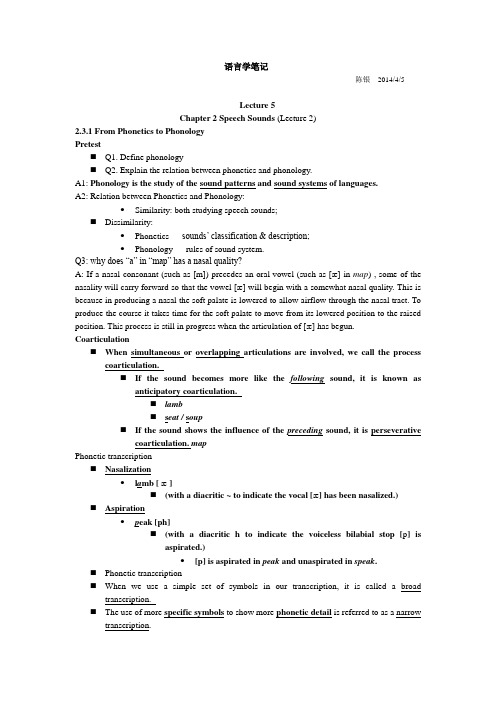
语言学笔记陈银2014/4/5Lecture 5Chapter 2 Speech Sounds (Lecture 2)2.3.1 From Phonetics to PhonologyPretest⏹Q1. Define phonology⏹Q2. Explain the relation between phonetics and phonology.A1: Phonology is the study of the sound patterns and sound systems of languages.A2: Relation between Phonetics and Phonology:•Similarity: both studying speech sounds;⏹Dissimilarity:•Phonetics --- sounds‟ classification & description;•Phonology --- rules of sound system.Q3: why does “a” in “map” has a nasal quality?A: If a nasal consonant (such as [m]) precedes an oral vowel (such as [æ] in map) , some of the nasality will carry forward so that the vowel [æ] will begin with a somewhat nasal quality. This is because in producing a nasal the soft palate is lowered to allow airflow through the nasal tract. To produce the course it takes time for the soft palate to move from its lowered position to the raised position. This process is still in progress when the articulation of [æ] has begun.Coarticulation⏹When simultaneous or overlapping articulations are involved, we call the processcoarticulation.⏹If the sound becomes more like the following sound, it is known asanticipatory coarticulation.⏹lamb⏹s eat / s oup⏹If the sound shows the influence of the preceding sound, it is perseverativecoarticulation. mapPhonetic transcription⏹Nasalization•l a mb [ æ ]⏹(with a diacritic ~ to indicate the vocal [æ] has been nasalized.)⏹Aspiration•p eak[ph]⏹(with a diacritic h to indicate the voiceless bilabial stop [p] isaspirated.)•[p] is aspirated in peak and unaspirated in speak.⏹Phonetic transcription⏹When we use a simple set of symbols in our transcription, it is called a broadtranscription.⏹The use of more specific symbols to show more phonetic detail is referred to as a narrowtranscription.⏹Diacritics: the set of symbols in IPA, which are added to the letter-symbols to bring outfiner distinctions than the letters alone may possibly do.pit [phit]⏹ Broad transcription with letter-symbols only spit [spit]⏹Narrow transcription with letter-symbols together with the diacritics. pit [p h it]e.g.clear [ l ] as in let, play ( before a vowel: clear)[ l ]dark [ ɫ ] as in tell, feel (after a vowel: dark)aspirated [ ph] as in pit, peak[ p]unaspirated [ p] as in spit, speed1. The space between the two vocal cords is called ______.2.The most flexible speech organ in articulation is the ______.3. When produced with somewhat obstruction of the airflow somewhere in the mouth, thesounds must be ______.4. Phoneticians apply two standards to classify consonants: one is _____________________,i.e. the part of the vocal tract at which the constriction, obstruction or block is formed; theother is____________________, i.e. the way that the airstream is blocked, constricted, or obstructed.5. The consonants that are produced by closing the two lips first and let them open with theburst of the airflow are called_________.6. The two interdentals in English are the voiceless ___ and the voiced ___ respectively.7. The English consonants are either ______ or ______ depending on whether thevelum is raised or lowered.2.3.2 Phonemes⏹Phonology is not specifically concerned with the physical properties of the speechproduction system.•Phoneticians are concerned with how sounds differ in the way they are pronounced while phonologists are interested in the patterning of such soundsand the rules that underlie such variations.⏹Crystal: …Phonological analysis relies on the principle that certain sounds cause changesin the meaning of a word or phrase, whereas other sounds do not‟.•Minimal pairs test•PhonemesMinimal pairs(最小对立体):Phonological analysis relies on the principle that certain sounds cause changes in the meaning of a word.e.g. [t] and [d]: tin/din, tie/die[i:] and [i]: beat/bit, bead/bidThese important units are called phonemes2.2.1 Minimal PairDefinition:• A minimal pair refers to two different words which are identical in every way in pronunciation except one sound that takes place at the same position.Examples:•[pit] vs. [bit]•[bet] vs. [bæt]Minimal pairs最小对立对⏹Three requirements for identifying minimal pairs:•1) different in meaning;•2) only one phoneme different;•3) the different phonemes occur in the same phonetic environment.⏹ e.g. p at vs. fat⏹Minimal set: pat, mat, bat, fat, cat, hat, etc.The phoneme theoryPhoneme: units of explicit sound contrast, built on the idea of contrastLanguages differ in the selection of contrastive sounds.In English, the distinction between aspirated [ph] and unaspirated [p] is not phonemicBy convention, phonemic transcriptions are placed between slant lines (//), while phonetic transcriptions are placed between square brackets ([ ]).In phonetic terms, phonemic transcriptions represent the “broad” transcriptionPhone /phonemebead bean pit spit[bi:d] [b ĩ:n] [phit] [spit]⏹/b/ /i:/ /d/ /n/ /p//i/ /s/ /t/—phonemes⏹[b] [i:] [d] [ ĩ:] [n] [ph ] [p] [ i ] [t] [s]—phonesPhoneDefinition:A phone refers to the smallest perceptible discrete segment of sound in a stream of speechExamples:•[p], [e], [n] in [pen]•[b], [u], [l], [i], [t] in ['bulit];Phoneme音位⏹Any speech sound segments that can distinguish or contrast words in sound andmeaning are called phonemes.⏹ A phoneme is the minimal or smallest distinctive linguistic unit in a language.⏹Languages differ in the selection of contrastive sounds.⏹In English, the distinction between aspirated [ph]and unaspirated [p]is notphonemic. [fəuˈni:mik]⏹In Chinese, however, the distinction between /p/ and /ph/ is phonemic.Phone vs. phonemePhone:phonetic unit A phone refers to the smallest perceptible discrete segment of sound in a stream of speech.physical as heard or produced marked with [ ]Phoneme: phonological unit Any speech sound segments that can distinguish or contrast wordsin sound and meaning are called phonemes. /A phoneme is the minimal or smallest distinctive linguistic unit in a language. Abstract marked with / /2.3.3 Phoneme & Allophones⏹Definitions:A phoneme is the minimal or smallest distinctive linguistic unit in a language.Allophones are phonic variants of a phoneme, which share more phonetic features in common and which are phonetically conditioned each.Allophones are possible variants or realization of a phoneme in different phonetic environment. allophone 音位变体⏹allophone: phonic variants/realizations of a phoneme⏹ A phoneme is realized as allophone1+allophone2+….• e.g. /p/=[ ph ] + [ p]⏹In this case the allophones are said to be in complementary distribution because theynever occur in the same context:⏹ALLOPHONES (音位变体): the variants of a phoneme⏹ALLOPHONY/ALLOPHONIC V ARIATION: the phenomenon of variation in thepronunciation of phonemes in different position⏹COMPLMENTARY DISTRIBUTION(互补分布): the allophones never occur in thesame context(1) /p/ [p=] / [s] __________[ph] elsewhere(2) /l/ [l] / _______ V[ł]/ V _______●Q: Are all the phones in complementary distribution allophones?⏹PHONETIC SIMILARITY (语音相近): allophones of a phoneme must bear somephonetic resemblanceE.g. [l, ł] lateral approximants only differing in places of articulation●NOTE: Allophy: complementary distribution + phonetic similarity⏹FREE V ARIANTS: the pronunciation difference may be caused by dialect, habit, region,or individual preference, instead of by any distribution ruleIndividual differenceE.g., cup: [khΛph], [khΛp┐]┐: no audible releaseDialectical differenceE.g., either: [i:ðə], [aiðə]2.4 Phonological processes and phonological rules2.4.1 AssimilationNasalization, dentalization, and velarization are all instances of assimilation, a process by which one sound takes on some or all the characteristics of a neighboring sound.1.If a following sound is influencing a preceding sound, we call it regressiveassimilation.2.If a preceding sound is influencing a following sound, it is known as progressiveassimilation.⏹These changes exhibit PHONOLOGICAL PROCESSES in which a TARGET orAFFECTED SEGMENT undergoes a structural change in certain ENVIRONMENTS or CONTEXTS.⏹In each process the change is conditioned or triggered by a following sound.⏹Any phonological process must have three aspects to it:⏹A) a set of sounds to undergo the process⏹B) a set of sounds produced by the process⏹C) a set of situations in which the process applies⏹/v/ ◊ [f] /z/ ◊ [s] etc.⏹voiced fricative ◊ voiceless / ____ voiceless⏹This is a PHONOLOGICAL RULE.⏹ A voiced fricative is transformed into the corresponding voiceless sound when itappears before a voiceless sound.⏹Nasalization rule:[-nasal] ◊ [+nasal] / ____ [+nasal]⏹Dentalization rule:[-dental] ◊ [dental] / ____ [dental]⏹Velarization rule:[-velar] ◊ [+velar] / ____ [+velar]⏹DEVOICING(清音化): a process by which voiced sounds become voiceless, in suchcontexts does not occur with other sounds (such as stop and vowels)E.g., [f, v; θ, ð; s, z; ʃ; ʒ; t ʃ; dʒ]●/v/ [f]V oiced fricatives are transformed into voiceless fricatives before voiceless segments.●voiced fricative voiceless/ ________ voiceless“A voiced fricative is transformed into the corresponding voiceless sound when it appears before a voiceless sound.”⏹PHONOLOGICAL PROCESSES :a process in which a TARGET or AFFECTED SEGMENT undergoes a structural change in certain ENVIRONMENTS or CONTEXTS⏹Three aspects of phonological processa set of sounds to undergo the process;a set of sounds produced by the process;a set of situations in which the process applies.⏹PHONOLOGICAL RULE“/” : to specify the environment in which the change takes placeFocus bar (焦点横线): to indicate the position of the target segmentE.g., Nasalization rule[- nasal] [+nasal]/_____[+ nasal]Dentalization, velarization rule2.4.2 Epenthesis, Rule Ordering and Elsewhere ConditionEx.a. a hotel, a boy, a white houseb. an apple, an honour, an old lady●NOTE: It is the lack of a consonant that requires the nasal [n] to be added to the article“a”.⏹EPENTHESIS : the process of inserting a nasal soundØ [n] / [ə] ________ V●NOTE: The regular plural and past tense forms also exhibit similar rules.Ex.a. desk [dεsk] desks [dεsks]b. chair [tʃeə] chairs [tʃeəz]c. bus [bΛs] buses [bΛsəz]⏹-(e)s: [s], [z], [əz] (See pp. 45)⏹/s/ is found after /t, k/ (the preceding sound is a voiceless consonant other than / s, ʃ, tʃ/)⏹/z/ appears after: /l, ə, n, b, d, g, əu/ (the preceding sound is a vowel or a voiced consonant)other than /z, ʒ, dʒ /⏹/əz/ occurs after /s, z, ʃ, ʒ, tʃ, dʒ /SIBILANTS(咝擦音): a speech sound (consonant) which is produced with friction and which has an s-like quality, e.g., /s, z, ʃ, ʒ, tʃ, dʒ /For the plural forms:⏹The /s/ appears after voiceless sounds.⏹The /z/ appears after voiced sounds.⏹The /əz/ appears after sibilants.UNDERLYING FORM / UNDERLYING REPRESENTATION (UR): the basic form (or the form which appears in most cases), e.g., /z/SURFACE FORM / SURFACE REPRESENTATION (SR):the derived form, e.g., /s, əz/⏹z s/[-voiced, C]________⏹Ø [ə]/sibilant _____ [z]a. //si:t + z//b. //bε d + z//c. //keIs + z//s N/A *s Devoicing N/A N/A N/A Epenthesissi:ts bεdz *keIss Outputa. //si:t + z//b. //bε d + z//c. //keIs + z//N/A N/A ə Epenthesiss N/A N/A Devoicingsi:ts bεdz keIsəz OutputConclusion:Epenthesis is applied before devoicing.⏹Rule ordering⏹Elsewhere Condition: The more specific rule applies first.2.4.3 Distinctive features⏹The idea of Distinctive Features was first developed by Roman Jacobson (1896-1982) inthe 1940s as a means of working out a set of phonological contrasts or oppositions to capture particular aspects of language sounds.Distinctive Feature Theory⏹Distinctive feature theory was proposed by Roman Jakobson in the1950s.⏹The core of it is binary opposite.⏹The purpose of it to reduce the number of phonemic features to the minimum so thatsome main features can be used to explain all the oppositions of phonemes in all the languages in the world.⏹For example, aspiration is a distinctive feature in Chinese . While voicing is a distinctivefeature in English.⏹Distinctive features⏹phonetic features :contrast meanings of words / distinguish onephoneme from another.Distinctive featurese.g. [±voiced]Examples:•[b it]vs.[p it]•[d ip]vs.[t ip]•[g id]vs.[k id]Nondistinctive featurese.g [ ±aspirated ]; [ ±nasal ]Examples:•[spit] [phit];•[stik] [sthik];•[skip] [skhip];•[b i:n] [sbĩ:n]Distinctive features⏹Some of the major distinctions include [consonantal], [sonorant], [nasal] and [voiced].•[consonantal] : consonants [+consonantal]vowels [–consonantal]•[sonorant] : obstruents [–sonorant]•others [+sonorant]⏹[sonorant] distinguishes between obstruents (stops, fricatives andaffricates) and sonorants (all other consonants and vowels)⏹These are known as binary features denoted by ‘ + ’ and ‘–’.ReviewDistinctive features Exercises⏹Specify the difference between each pair of sounds using features.⏹l.[l] [ɫ] 2.[ph] [p] 3.[ tʃ] [d3] 4.[k] [g] 5.[i] [u]2.5 Suprasegmentals⏹Suprasegmental features are those aspects of speech that involve more than singlesound segments.⏹The principal suprasegmentals are:2.5.1 The syllable structurec.f. Chinese and English syllable structure⏹Chinese: MONOSYLLABIC (with one syllable)⏹English: MONOSYLLABIC or POLYSYLLABIC (with more than one syllable)⏹NUCLEUS/PEAK (核心/峰): vowel or consonant, e.g., table [teibl]:[tei], [bl]⏹RHYME (or RIME) (韵基), ONSET (节首)⏹NUCLEUS (核心): the vowel within the rhyme⏹CODA (节尾): the consonant(s) after the nucleus⏹Open syllable: bar, tie⏹Closed syllable: bard, tied⏹Maximal Onset Principle (MOP)•When there is a choice as to where to place a consonant, it is put into the onset rather than the coda.•This explains the question of why /l/ in telling is pronounced as the clear [l].2.5.2 Stress⏹Stress refers to the degree of force used in producing a syllable. In transcription, araised vertical line [│] is often used just before the syllable it relates to.• A basic distinction i s made between stressed and unstressed syllables, the former being more prominent than the latter, which means that stress is a relativenotion.⏹At the word level, it only applies to words with at least two syllables.⏹At the sentence level, a monosyllabic word may be said to be stressed relative to otherwords in the sentence.⏹The stress pattern in English is no easy matter. In principle, the stress may fall on antsyllable. They also change over history and exhibit regional or dialectal differences. Changing English Stress PatternBecoming norm⏹inTEGral⏹coMMUNal⏹forMIDable⏹conTROVersy⏹INtegral⏹COMMunal⏹FORmidable⏹CONtroversyRP vs. GARP⏹laBORatory⏹DEBris⏹GARage GA⏹LABoratory⏹deBRIS⏹gaRAGEV vs. NVerb⏹conVICT⏹inSULT⏹proDUCE⏹reBEL Noun⏹CONvict⏹INsult⏹PROduce⏹REbelCompound vs. PhraseCompound Phrase⏹BLACKboard ⏹BLACKbird ⏹black BOARD ⏹black BIRDPrimary vs. Secondary StressepiphenomenalunsatisfactorydiscriminationstandardizationcommunicationindustrializationSentence Stress⏹Sentence stress is much more interesting. In general situations, notional words arenormally stressed while structural words are unstressed.⏹Sentence stress is often used to express emphasis, surprise, etc. so that in principle stressmay fall on any word or any syllable.e.g.John bought a red car.JOHN bought a red car.John BOUGHT a red car.John bought a RED car.John bought a red CAR.2.5.3 Intonation⏹Intonation involves the occurrence of recurring fall-rise patterns, each of which isused with a set of relatively consistent meanings, either on single words or on groups of words of varying length.For example, the fall-rise tone in English typically involves the meaning of a contrast within a limited set of items stated explicitly or implicitly.(Isn’t her name Mary?) No / ∨ Jenny⏹The old man didn‟t come / whereas the ∨young man / did come and actually enjoyedhimself⏹∨I didn‟t do it2.5.4 ToneChinese tone changes are used in a different way, affecting the meanings of individual words.Languages like Chinese are known as tone languages.Study Questions1. Define the following terms:coarticulation phonemeallophone assimilationstress intonation2. What is the difference between an allophone and a phoneme?3. Which of the following words would be treated as minimal pairs?ban, fat, pit, bell, tape, heat, meal, more, pat, pen, chain, vote, bet, far, bun, goat, heel,sane, tale4. What is assimilation and what is a phonological rule?5. What is the difference between an open and a closed syllable?6. Individual sounds are described as segments. What are suprasegmentals? Group WorkGroup 5 Chapter 3 3.1。
Lecture 7 level of words 《英语写作手册》丁往道编 外研社
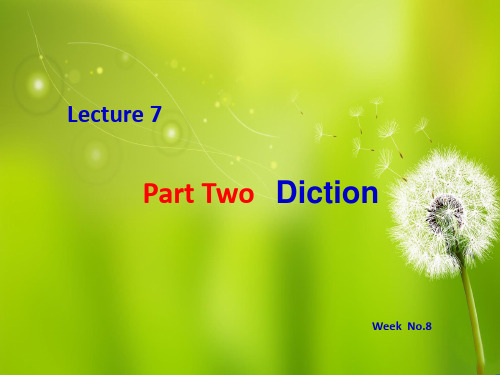
• 这是林肯总统给烈士母亲比克斯比夫人慰问信中的一句
话。比克斯比夫人的五个儿子都在南北战争中光荣牺牲。 句中用了文体正式程度很高的词.
• Now compare these pairs of verbs: • Common
• 1. He checked up on his accountant. • 2.They put up with their neighbors. • 3.She caught on very quickly. • 4.She made up for it with an early night. • 5.He went down with a fever. The cost of living went up.
mon/ Neutral (good for all kinds of writing) —Most frequently used
• College papers • Mass publications • Business communications
—For educated persons
e.g.: It is very/damn great. 2. Using the Exact Word
—Meaning of words e.g.: major study / academic study 3. Using Figurative Language
—Figures of speech e.g.: My love is like a red, red rose.
Lecture 5 - Format
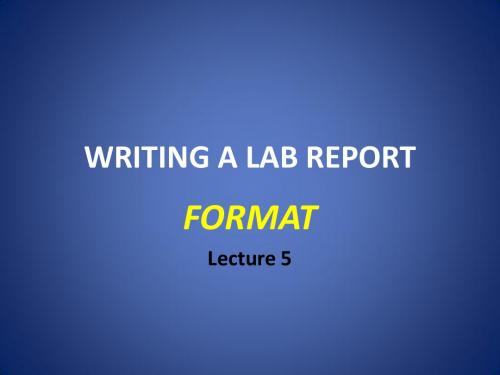
WHITE SPACE
Space for emphasis: e.g. Equations are put in separate line from text & in the centre of line Space for hierarchy: show division of sections b/w text & illustrations, use suitable headings & subheadings (separate main parts from subparts)
LAYOUT OF CONTENT
5. Results 5.1 -----------------------------------------------5.2 -----------------------------------------------5.3 -----------------------------------------------6. Discussion 6.1 -----------------------------------------------6.2 -----------------------------------------------6.3 ------------------------------------------------
Formal Lab Report
Journal Article
Typography: Not all rules of format are constant Lab Reports Figure 1 Table 1 equation 1 Journal Articles fig.1 table 1 Eq. 1
Lecture_5-_What_is_Motivation__Needs_The

Maslow’s Hierarchy
• 5 Basic Categories of Human Need • Account for much or most of human behavior, but not all of it • Vary in terms of urgency for survival, which is how “hierarchy” comes into play • As the most urgent becomes relatively satisfied, the less urgent ones become increasingly important in terms of causing behavior.
The Role of Needs in Work Motivation
1.
2. They can only be partially satisfied habitually, either by choice or force 3. Need frustration is experienced as pain, discomfort or illness 4. Different needs signal different degrees of urgency
Maslow’s Hierarchy
• Safety
o
o When unfulfilled, they possess the same sort of potential for dominating behavior as physiological needs
o o Only effective when combined with the ability and opportunity
Lecture_5_Negotiation

What is Negotiation?
Definition
‘Discussion with another with a view to compromise’
Negotiation should result in a situation where both parties feel reasonably satisfied, ie both feel as if they have achieved something.
Input (Problem)
The problems which arise when two people (groups) have different views about a course of action
A two way exchange 2 Identification of common ground 3 Attempts to accommodate or reconcile differences 1
In the first instance its important to really listen to ensure you clearly understand what is being said. In the second instance you need to stop talking once a proposal has been made to allow the other party to reflect and answer the proposal Consider alternative proposals. Give what they want on
TRADEABLES TO Consider When Negotiating
lecture
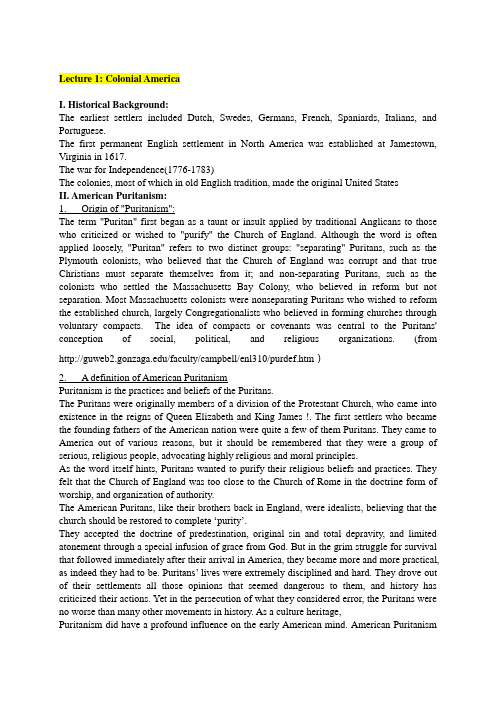
Lecture 1: Colonial AmericaI. Historical Background:The earliest settlers included Dutch, Swedes, Germans, French, Spaniards, Italians, and Portuguese.The first permanent English settlement in North America was established at Jamestown, Virginia in 1617.The war for Independence(1776-1783)The colonies, most of which in old English tradition, made the original United StatesII. American Puritanism:1. Origin of "Puritanism":The term "Puritan" first began as a taunt or insult applied by traditional Anglicans to those who criticized or wished to "purify" the Church of England. Although the word is often applied loosely, "Puritan" refers to two distinct groups: "separating" Puritans, such as the Plymouth colonists, who believed that the Church of England was corrupt and that true Christians must separate themselves from it; and non-separating Puritans, such as the colonists who settled the Massachusetts Bay Colony, who believed in reform but not separation. Most Massachusetts colonists were nonseparating Puritans who wished to reform the established church, largely Congregationalists who believed in forming churches through voluntary compacts. The idea of compacts or covenants was central to the Puritans' conception of social, political, and religious organizations. (from /faculty/campbell/enl310/purdef.htm)2. A definition of American PuritanismPuritanism is the practices and beliefs of the Puritans.The Puritans were originally members of a division of the Protestant Church, who came into existence in the reigns of Queen Elizabeth and King James !. The first settlers who became the founding fathers of the American nation were quite a few of them Puritans. They came to America out of various reasons, but it should be remembered that they were a group of serious, religious people, advocating highly religious and moral principles.As the word itself hints, Puritans wanted to purify their religious beliefs and practices. They felt that the Church of England was too close to the Church of Rome in the doctrine form of worship, and organization of authority.The American Puritans, like their brothers back in England, were idealists, believing that the church should be restored to complete …purity‟.They accepted the doctrine of predestination, original sin and total depravity, and limited atonement through a special infusion of grace from God. But in the grim struggle for survival that followed immediately after their arrival in America, they became more and more practical, as indeed they had to be. Puritans‟ lives were extremely disciplined and hard. They dro ve out of their settlements all those opinions that seemed dangerous to them, and history has criticized their actions. Yet in the persecution of what they considered error, the Puritans were no worse than many other movements in history. As a culture heritage,Puritanism did have a profound influence on the early American mind. American Puritanism also had an enduring influence on American literature. It had become, to some extent, somuch a state of mind, so much a part of the national cultural atmosphere, rather than a set of tenets.3. 21st Century PuritanismA "21st Century Puritanism", then, is the always-reforming spirit of 17th-century Puritanism applied to the challenges of the 21st century church. In place of an Arminian "free-will" gospel that exalts human worth and ability, the 21st Century Puritan calls us back to the Biblical gospel that exalts the power and sovereignty of Almighty God. In place of the "seeker-sensitive", man-pleasing paradigm for worship, the 21st Century Puritan points us back to the Biblical, God-ordained pattern of worship revealed in Scripture—emphasizing a Godward focus—preaching His glories, rejoicing in His mercy to hell-deserving sinners, falling at His feet in humble supplication, singing from joyful, forgiven, God-saturated hearts psalms and hymns that exalt His majesty and honor.(for further information, please go to /puritan)III. Puritan PoetsAnne Bradstreet (the ninth muse):"CONTEMPLATIONS" comprises thirty-three stanzas rhyming ababccc, in which six iambic pentameter lines culminate with an alexandrine. Adopting the models of Fletcher and Quarles (Stanford 101), Bradstreet, with her three "c" rhymes and closing alexandrine, modifies the nine-line stanza of The Faerie Queene; this formal kinship with Spenser is compounded by the pace of her narrative. The work was probably completed in the 1660s.First appearing in the posthumous Several Poems, "Contemplations" belongs to a later group of writings, often domestic in their subject matter, in which Bradstreet's personal voice achieves its graceful maturity.(For further information, please go to: /~mseifert/bradstreet.html)2. Edward Taylor: "Huswifery" (Chang, p19)IV. Representatives of Dawning NationalismPhilip Freneau: "The Wild Honey Suckle" (Chang, p23),"The Indian Burying Ground" Benjamin FranklinLecture 2-4: American RomanticismI. Historical Background:American pioneers had pushed the frontier line of settlement beyond the Mississippi to the west, which has risen as a sectional power to challenge the political dominance of the East and the South.Before 1860, the United States had begun to change into an industrial and urban society. Literary characteristics: Romanticism, TranscendentalismThe rise of NationalismII. American RomanticismThe Romantic Period in the history of American literature stretches from the end of the 18thcentury to the outbreak of the Civil War, which started with the publication of Washington Irving's The Sketch Book and ended with Whitman's Leaves of Grass.In this period, a new emphasis was placed upon the imaginative and emotional qualities of literature, a liking for the picturesque, the exotic, the sensuous, the sensational, the supernatural and remote past was fostered, and an increasing attention to the psychic states of their characters was paid, and above all, the individual and the common man was exalted. Dr. F. H. Hedge, an American transcendentalist, thought the essence of romanticism was aspiration, having its origin in wonder and mystery.Among the aspects of the "romantic" movement in England may be listed as a) sensibility; b) primitivism; c) love of nature; d) sympathetic interest in the past, especially the medieval; e) mysticism; and f) individualism.III. Two Earlier WritersWashington IrvingJames Fenimore CooperIV. American TranscendentalismThe most clearly defined literary thought in this period is New England Transcendentalism. 1. The definition of TranscendentalismTranscendentalism has been defined philosophically as "the recognition in man of the capacity of knowing truth intuitively, or of attaining knowledge transcending the reach of the senses."Principal ideas of Transcendentalism are based on doctrines of ancient and modern European philosophers, particularly Kant. It was started by a group of members of the Transcendental Club in New England in the 1830s, whose leaders were Emerson, who was greatly influenced by Carlyle, Coleridge and others, and his young friend Thoreau.The major concepts include:it stresses the power of intuition.2. it places spirit first and matter second.3. it takes nature as symbolic of spirit or God.(认为自然是上帝之灵的显现,说自然就是披着睡衣的:超灵(over-soul),对人的心灵有更新和康健卫生作用。
托福听力学科分类(完全修正版)(可编辑修改word版)
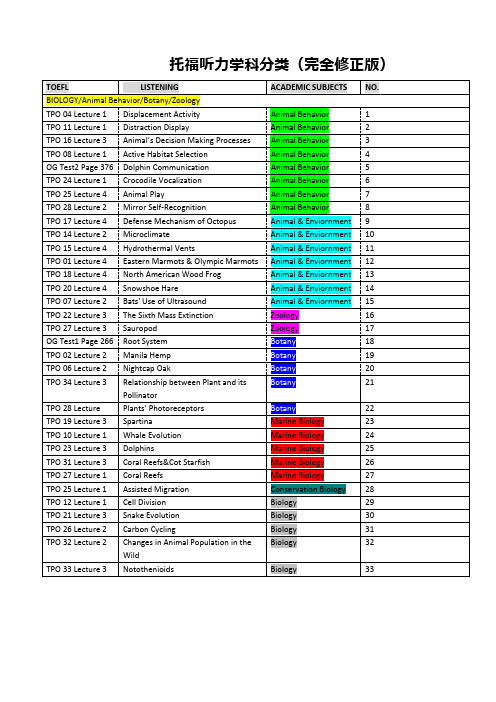
8
TPO 22 Lecture 2
Faint Young Sun Paradox
Astronomy
9
TPO 24 Lecture 4
Shield Volcanoes on Venus
Astronomy
10
TPO 26 Lecture 3
The Orbits of Comets
Astronomy
ArtHistory
11
TPO 21 Lecture 4
Alice Neel (Artist)
Art History
12
TPO 33 Lecture 4
Renaissance Gardens
ArtHistory
13
TPO 34 Lecture 1
Dada
ArtHistory
14
TPO 15 Lecture 3
Nightcap Oak
Botany
20
TPO 34 Lecture 3
Relationship between Plant and its
Pollinator
Botany
21
TPO 28 Lecture
Plants’ Photoreceptors
Botany
22
TPO 19 Lecture 3
Spartina
Animal & Enviornment
13
TPO 20 Lecture 4
Snowshoe Hare
Animal & Enviornment
14
TPO 07 Lecture 2
Bats' Use of Ultrasound
Word Explanation
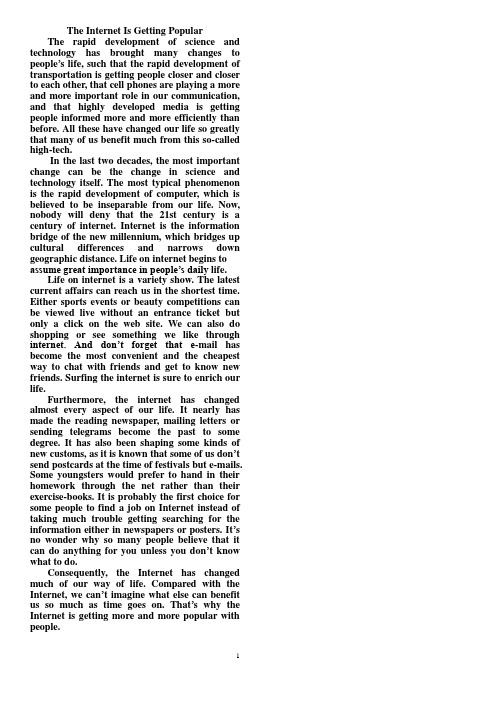
The Internet Is Getting PopularThe rapid development of science and technology has brought many changes to people’s life, such that the rapid development of transportation is getting people closer and closer to each other, that cell phones are playing a more and more important role in our communication, and that highly developed media is getting people informed more and more efficiently than before. All these have changed our life so greatly that many of us benefit much from this so-called high-tech.In the last two decades, the most important change can be the change in science and technology itself. The most typical phenomenon is the rapid development of computer, which is believed to be inseparable from our life. Now, nobody will deny that the 21st century is a century of internet. Internet is the information bridge of the new millennium, which bridges up cultural differences and narrows down geographic distance. Life on internet begins to assume great importance in people’s daily life.Life on internet is a variety show. The latest current affairs can reach us in the shortest time. Either sports events or beauty competitions can be viewed live without an entrance ticket but only a click on the web site. We can also do shopping or see something we like through internet. And don’t forget that e-mail has become the most convenient and the cheapest way to chat with friends and get to know new friends. Surfing the internet is sure to enrich our life.Furthermore, the internet has changed almost every aspect of our life. It nearly has made the reading newspaper, mailing letters or sending telegrams become the past to some degree. It has also been shaping some kinds of new customs, as it is known that some of us don’t send postcards at the time of festivals but e-mails. Some youngsters would prefer to hand in their homework through the net rather than their exercise-books. It is probably the first choice for some people to find a job on Internet instead of taking much trouble getting searching for the information either in newspapers or posters. It’s no wonder why so many people believe that it can do anything for you unless you don’t know what to do.Consequently, the Internet has changed much of our way of life. Compared with the Internet, we can’t imagine what else can benefit us so much as time goes on. That’s why the Internet is getting more and more popular with people.Alliteration The repetition of the same consonant sounds or of different vowel sounds at the beginning of words or in stressed syllables, as in Proud as a peacock /blind as a batArchbishop A bishop of the highest rank, heading an archdiocese or a province.Cabinet A body of persons appointed by a head of state or a prime minister to head the executive departments of the governmentComedy A dramatic work that is light and often or satirical in tone and that usually contains a happy resolution of the thematic conflict.Constitutional monarchy A monarchy in whichrestricted to those granted under the constitution and laws of the nation.Crusade Any of the military expeditions undertaken by European Christians in the 11th, 12th, and 13th centuries to recover the Holy Land from the Moslems.Enlightenment A philosophical movement of the 18th century that emphasized the use of reason to scrutinize previously accepted doctrines and traditions and that brought about many humanitarian reforms.Exodus The departure of the Israelites from Egypt--.Genesis The coming into being of something; the origin.Gothic Of or relating to an architectural style prevalent in western Europe from the 12th through the 15th century and characterized by pointed arches, rib vaulting, and flying buttresses.Humanism A system of thought that centers on human beings and their values, capacities, and worth.Knighthood The rank, dignity, or vocation of a knight.Legend An unverified story handed down from earlier timesMythology A body or collection of myths belonging to a people and addressing their origin, history, deities, ancestors, and heroes. Nonverbal Gestures are a nonverbal means of expression.Oedipus complex In psychoanalysis, a subconscious sexual desire in a child, especially a male child, for the parent of the opposite sex Parish An administrative part of a diocese that has its own church in the Anglican, Roman Catholic, and some other churches.Parliament The national legislature of various countries, especially that of the United Kingdom, -made up of the House of Lords and the House ofCommons.Pragmatics The study of language as it is used inRenaissance The humanistic revival of classicalliterature, and learning that originated in Italy in the 14th century and later spread throughout Europe.Syllabus An outline or a summary of the mainsyntax The study of the rules whereby words or elements of sentence structure are combined to form grammatical sentences. Tragedy A drama or literary work in which the main character is brought to ruin or suffers extreme sorrowUtopia An ideally perfect place, especially in itsVersatile Capable of doing many things competently.Having varied uses or serving many functions:1.abide遵守stick to2.actuate-开动-set in motion3.affluent富裕的wealthy4.allude- Refer to5.antiquate- 废弃obsolete6.apparel.衣服clothing7.apprehension忧惧fear8.arboreal-树栖的tree-dwelling9.bashful害羞的shy10.bore钻孔drill11.breed-抚养mate12.buckle变弯曲bend13.concede-承认admit14.corroborate 确证confirm15.decompose-腐烂decay16.dehydrate-脱水dry17.direct-支配run18.discord不和谐dishamony19.dubious可疑的doubtful20.ebb衰落vanish21.ecstatic狂喜的, 入迷的lighted hearted22.endorse认可, 签署approve23.evacuate撤出, 排泄remove24.exigency-苛求urgent needs25.exorbitant过度的excessive26.explicit清楚的definite27.extemporaneous即席的without notes28.fabulous-惊人的amazing29.flicker-闪烁shine unsteadily30.fugitive逃亡的, 易变的runaway31.furrow犁沟trench32.germinate使生长grow33.germinate发芽sprout34.grievance committee不平(scholarship)35.impel推动motivating36.impromptu即席演出unrehearsed37.inadvertently-不注意地unintentionally38.incessant不停的unending39.indispensable不可缺少的essential40.inert迟钝的odorless无嗅的41.intrepid无畏的fearless42.itinerant巡回的travelling43.jerk[dVE:k]vt.猛拉abruptly pull44.lodge in 留在deposite in45.lustre光泽distinction殊荣46.lustrous-光辉的shiny47.maim使不能工作cripple48.negligible微不足道的minimal49.obese-肥大的excessively overweight50.outrun-超过surpass51.partake共享share52.ponder沉思consider carefully53.prune修剪trim54.quarantine检疫isolated for medical reasons55.raze夷为平地demolish56.rustic粗俗的simple57.skeptical-不信服的unconvinced58.skip急速改变turn over59.slope-倾斜slant60.sluggish-行动迟缓的slow61.spell out-讲清楚clarify62.subsequent后来的later63.superannuate因年老而辞退senile64.tacit默许的unspoken65.vex使烦恼annoy66.vulnerable易受攻击的, susceptible。
lecture 5 word formation

21) rupt: to break, or to burst interrupt: to break the flow of sth. bankrupt 22) spect (spec, spic): to look, to see inspect: to examine respect introspect retrospect
7) cad (cid): to fall, to happen by chance accident incident 8) ced (cede, ceed, cess): to go, yield antecedent: a thing, event, etc. coming or being before another suc(near)+ ceed ( pro(向前)+ ceed 继续 向前) 向前 Pre(在前)+ cede 处在 之前 处在…之前 (在前) precedence领先 precedential有先例的 领先 有先例的 9) cid-: to cut, kill suicide insecticide
4.1.2 Prefix 1) a-: not; without: amoral (不属于道德范畴的 不属于道德范畴的) 不属于道德范畴的 cf. immoral不道德的 atypical aperiodic 不道德的 Before letter h or a, a- is changed into an-: Anarchy:an-: without+archy:head or chief Anhydrous: an(without)+hydro(water)+ous 2) dis-:not; without disadvantage disobedient Before f, dis- is changed into dif Difficult: (ficult=facile=easy) diffidence(to distrust) lack of self-confidence
Lecture_5-new
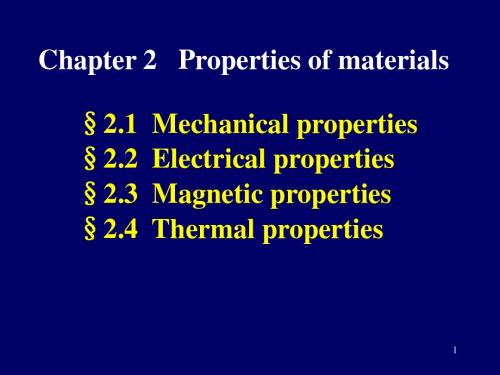
n=c/v The index of refraction depends on the wavelength.
18
When the light enters another materials: • The frequency does not change. • The wavelength differs from that in a vacuum. • Optical density: the greater the index the greater is the optical density, and the smaller the speed of light.
10
1.2 Mechanical waves: light waves, water waves, sound waves (1) Requirement: some medium to travel Oscillations 振动 Carrying energy
11
(2)
Parameters Wavelength Frequency f : 1Hz = 1 cycle per second Velocity v: v = / f
400 nm ~ 750 nm
velocity of light c: c = / f
17
(3)
Index of refraction n 折射率: the ratio of the speed of light in vacuum to the speed of light in a medium.
Chapter 2 Properties of materials
§2.1 §2.2 §2.3 §2.4
lecture 1
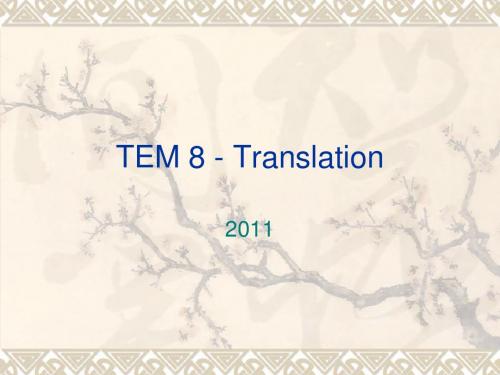
中国与东盟各国或山水相连,或隔海相望,
在悠久的交往中,人民之间形成了深厚的传 统友谊。 Joined together by mountains and rivers or facing each other across the sea, China and ASEAN countries have developed a profound traditional friendship among the people in the course of their age-old contacts and exchanges.
世人常称大学为“最高学府”,这名称
易滋误解,好像过此以上即无学问可言。 大学的研究所才是初步研究学问的所在。 A university has often been misleadingly referred to as “the highest seat of learning”, which sounds as if there were no more learning to speak of beyond it. The research institute of a university, however, is the place for preliminary scholarship.
庞贝城现在成了举世闻名的游览地,人们可
Байду номын сангаас
以在这里赞赏自然界的伟力与人类的创造才 能,发出繁华如过眼烟云之类的种种感慨, 享受地中海的太阳与和风。 Pompeii has now become a world renowned tourist spot. People visiting this place can admire the power of nature, the creativity of man or sigh with emotion that glory and prosperity are as transient as fleeting clouds. They can also enjoy the sunshine and the soft breeze of the Mediterranean.
lecture 5
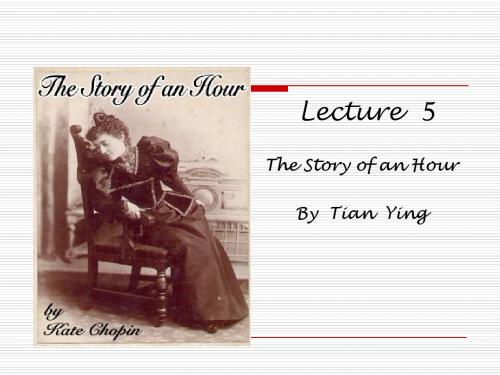
Character
Definition of “character” (p.24) Character means the features and trait that form the individual nature of a person, and by extension, refers to one who typifies some definite quality.
Reading Questions
√
Mrs. Mallard, the heroine in the short story is A.a round character B. flat character In the short story, Mrs. Mallard’s sister Joseph, her husband friend Richard, and her husband Mr. Mallard are A. main characters B. foils C. antagonists D. protagonists
Reading Questions
What is the best word to describe Mrs. Mallard? A. lucky B. happy C. brave D. wretched (可怜的)
Reading Questions
Kate Chopin focuses on Mrs. Mallard’s presentation of ______ A. appearance B. character C. mental conflicts D. speech
Lecture 5
The Story of an Hour By Tian Ying
- 1、下载文档前请自行甄别文档内容的完整性,平台不提供额外的编辑、内容补充、找答案等附加服务。
- 2、"仅部分预览"的文档,不可在线预览部分如存在完整性等问题,可反馈申请退款(可完整预览的文档不适用该条件!)。
- 3、如文档侵犯您的权益,请联系客服反馈,我们会尽快为您处理(人工客服工作时间:9:00-18:30)。
*Imaginary things have no referents
7
Two referents for one thing ?
the same thing e.g.
conceptual structures
perceptual and action
Recommended readings: ? Jackendoff, R. (1992). Language of the mind. Essays on mental
representation. Chapter 3: Word meanings and what it takes to learn them: reflections on the Piaget-Chomsky. The MIT Press. pp. 53-67 ? Gao, H. (2001). The physical foundation of the patterning of physical action verbs. Lund University Press. Chapter 2: Lexicalization patterns from contact to motion and motion to contact. pp. 41-60
Lecture 5
26 Oct., 2005
Word, Meaning, and Concept
Helena Gao
1
Required readings: ? O' Grady, W. (1987). Semantics: the study of meaning. In W.
O'Grady & M. Dobrovolsky (eds.), Contemporary Linguistic analysis. Copp Clark Pitman Ltd. pp. 171-188 ? Vygotsky, L. (1996). Thought and Language. Newly revised and edited by Alex Kozulin. The MIT Press. Chapter 7: Thought and Word. pp. 210-276.
‘because' ? Abstract concepts like ‘love' ‘god'
6
According to referential theory,
Referent (denotation)
To equate meaning to a word or phrase with actual entities to which it refers e.g.
Paul Martin:
the Prime Minister of Canada
?
the leader of Liberal Party
8
Extension versus intention
- The distinction stipulates the relation between referents and meanings
2
? What is “word meaning”? ? What does it mean when you say you know
the meaning of a word?
? What does it mean when you say you know a word, such as “bird” “blue”, or “happy”
A word's extension corresponds to the set of entities that it picks out in the world (referents)
A word's intension corresponds to its inherent sense or the concepts that evoke.
9
According to Jackendoff (1992),
Within a cognitive theory
Conceptual Well-Formedness Rules
linguistic structures
conceptual structures
perceptual and action
? How do we conceive of a word meaning?
3
Word Meaning
? something that is conveyed or signified, or sensed in a symbolic sign
? A fragment of conceptual structure that is linked in long-term memory with a phonological structure and a syntactic structure (Jackendoff, 1992)
Inference rules
10
A number of factors combine to make a word mean what it does
(1) The connection of the concept expressed by the word to perception and action
4
Referential meaning
Rose =
Concept <-> word <-> object
5 = referent in the real world ? But what about extension of meaning
? Adjectives = qualities of something ? Grammatical function words e.g. ‘in' ‘on' ‘at'
